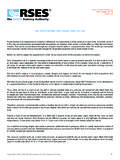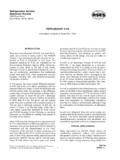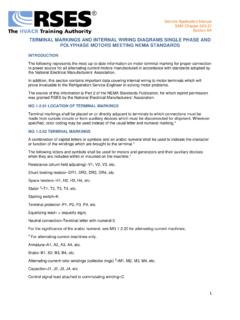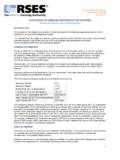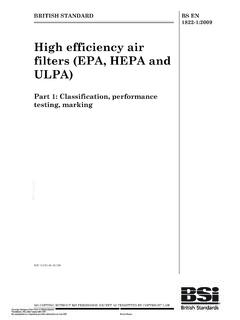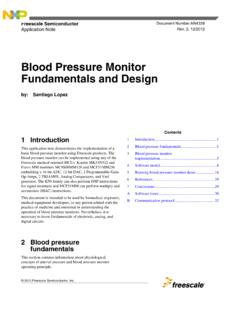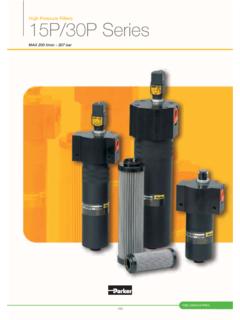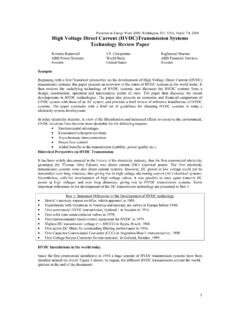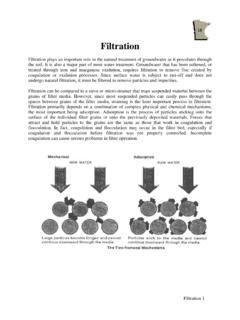Transcription of THE PRINCIPLES OF AIR FLOW, AIR PRESSURE, AND AIR …
1 PRINCIPLES OF AIR FLOWThe flow of air between two points is due to theoccurrence of a pressure difference between the twopoints. This pressure difference results in a forceplaced on the air, usually by a fan, causing the air toflow fromthe area of higher pressure to the area oflower pressure . The quantity of air, usually referredto in cubic feet per minute (cfm) is represented bythe symbolQ. The speed of flow or velocity of the air, usually referred to in feet per minute (ft/min), isrepresented by the symbolV. The size of the conduitthrough which the air flows, usually ductwork, isreferred to as area expressed in square feet (ft2) andis represented by the air flow through a conduit (ductwork) or a filteris expressed by the equation:Q=V ATherefore, to find either of the other values, theequation can be rewritten as:V=Q AA=Q VAn example of the application of this equation wouldbe a 24-in.
2 24-in. 2-in. flat panel filter (A= 4 ft2)placed in an airstream of 2000 cfm (Q= 2000 cfm).The velocity through the filter in this example wouldbe 500 ft/min (V= 2000 cfm 4 ft2= 500 ft/min). PRINCIPLES OF AIR PRESSUREAs air travels through a conduit, it creates a pressurecalledvelocity pressure (VP). There is a relationshipbetween velocity of the air and the velocity pressurebased on the density of the air. This relationship canbe expressed in the equation:where:V=velocity in feet per minute4005 = standard density of air derived from gravitational acceleration ( ft/sec2and air density of lb/ft3)VP= velocity pressure in inches of pressure is measured in the direction of flowthrough a conduit and isalways confined in a conduit (whether in motion or not)creates another type of pressure , which exerts itselfin all directions at the same time. Sometimes referredto as bursting pressure , this pressure is calledstatic pressure (SP).
3 Static pressure is independent of the velocity of the air and can beeither positive ornegative, depending on where it is measured in theconduit. Static pressure can be measured using aPitot tube. Figure 1 on the next page shows therelationship of velocity pressure and static PRESSURE, which is expressed in the equation:TP=SP+VPwhere:TP= total pressureSP= static pressureVP= velocity understand the pressure relationship, recognizethat the lowest pressure in a system is at the fan inletVVP=40051 THE PRINCIPLES OF AIR FLOW, AIR pressure , AND AIR FILTRATIONA dapted from the NAFA Guide to Air Filtration, published by the National Air Filtration with permission. 2008 by the Refrigeration Service Engineers Society, Des Plaines, ILSupplement to the Refrigeration Service Engineers Application ManualSAM Chapter 630-156 Section 11C (point A in Figure 2) and the highest pressure is atthe fan outlet (point B).
4 As a filter loads, for example,the resistance to flow causes an increase in thepressure on the upstream side of the filter and aresultant decrease on the downstream side. Thisdecrease in pressure between upstream anddownstream is referred to as pressure drop. Devices that measure filter pressure drop usuallymeasure static pressure increases in the systemcreated by a filter as it loads. This pressure isexpressed in inches of water gauge (see the inclinedtube manometer in Figure 3).As a filter loads in a system (depending on the typeof fan and its place on the fan curve), velocity of theair decreases as static pressure increases, causingthe system to work harder to deliver air to the increase in work by the fan results in increasedenergy consumption and higher owning and operatingcosts (seeNAFA Guide to Air FiltrationChapter 13: Owning and Operating Costs ). Figure 4 shows theeffect of this pressure in the OF PARTICULATE AIR FILTRATIONAir filters are devices that remove aerosols from anairstream as the particulate-contaminated air passesthrough them.
5 There are three types of air filtrationcategories mechanical air filters, filters incorporatingelectrostatically charged filter media, and electronicair cleaners. Mechanical air filterscapture particulates on thefilter media, the material that comprises the filterelement. This capture involves two different2 Air flow0. 501. 0 in. press ure+= in ..Velocitypr essur 0 in. pre ss ureFigure 1. pressure relationshipAir flowHig hFi lte rLowABFigure 2. Typical location of pressure dropmeasurement devicesFigure 3. pressure in a system is measured by aninclined tube manometer filled with red oilDWYERINSTRUMENTS considerations. The first is the probability that a particle will collide with or be removed by the fibers that make up the filter media. (The word fibers is used in the broadest sense to cover anycomponent of a filter media.) The second is theprobability that the particle, once contacting thefilter, will continue to adhere to the fiber.
6 Electrostatically charged filter media(passive andactive) have been used for several decades. Theadvantage of charged filter media is that thecharge on the fibers increases initial filtrationefficiency without affecting resistance to air have a natural charge, or pick up anelectrical charge as they pass through the particles, in turn, tend to stick to filterfibers. Electrostatically charged filter media may be used on stand-alone filters or may becombined with other technology to enhance theirperformance. Electronic air cleaners(two-stage) are externallypowered devices that impose a charge on airborneparticles in the ionizer section. The chargedparticles are then collected on oppositely chargedplates in the collector section. MECHANICAL AIR FILTERST here are four different processes responsible for thecapture of particulates in a mechanical filter . Usuallyone prevails in a specific filter , but rarely is it theexclusive mechanism.
7 These functions are: impingement interception diffusion the mechanism by which large, high -density particles are captured. As air flows through afilter, it must bend or change direction many times toflow around the filter fibers. Because of their inertia,larger particles resist change in direction and attemptto continue on in their original directions. For thisreason, they collide with, and adhere to, the fibers(see Figure 5).Interceptionoccurs when a particle follows theairstream, but still comes in contact with the fiber asit passes around it. If the forces of attraction betweenthe fiber and the particle are greater than the force of the air flow to dislodge it, the particle will stick to the fiber. Interception is enhanced when the size of the fiber is closest to the size of the particle (seeFigure 6 on the next page).3 Airflow,cfmPressuredrop, 4. pressure drop graphFigure 5.
8 ImpingementDiffusionexplains the capture of very small particlesat lower air velocities. As the contaminated air passesthrough the filter media, minute particles tend tomove from areas of higher concentration and take an erratic path described asBrownian motion. Thiserratic path increases the probability that particleswill come in contact with fibers and will stay attachedto them. Diffusion works best with fine filter fibersand very low air velocities (see Figure 7).Strainingoccurs when the smallest dimension of a particle is greater than the distance betweenadjoining filter media fibers (see Figure 8).Impingement filtersThe effectiveness of the impingement processdepends on the following: Particle larger the particle, the greaterthe mass and the greater the possibility that it willhave enough inertia to resist change in directionand collide with a fiber. Particle greater the density of aparticle, the greater the mass and the greater itsinertia.
9 Depth of the filter media and orientation of thicker the filter media and the closer theorientation of fibers, the greater the possibility of collision by a fiber. Velocity of air flow through the greaterthe velocity of air through a filter , the greater thekinetic energy of the particles in the airstream,and the greater the inertia of the and underrating filters not onlyimpacts the pressure drop and service life of afilter, but can also impact filter efficiency. If apanel filter is underrated, its overall efficiency on larger particles may actually be reduced. This is because most lower MERV filters utilizeimpingement as the main capture the air flow decreases the the velocity will decrease theimpingement process by reducing the kineticenergy of the particle in motion. This may4 Figure 6. InterceptionFigure 7. Diffusion effectFigure 8. Strainingincrease the capture of smaller particles bydiffusion and interception.
10 Conversely, overratingan impingement filter by increasing the air flowmay increase its overall efficiency on largerparticles (see note below) by increasing theimpingement process, but decrease the capture of smaller :Lower MERV (minimum efficiency reportingvalue) filters, which predominately utilize theimpingement capture principle, experience efficiencydecreases at a given point as velocity increases andturns downward (see dotted line in Figure 9), resultingin lower efficiencies even on larger particles. FiltersMERV 12and higher do not usually experience thisphenomenon because they utilize the PRINCIPLES ofinterception and diffusion as the predominant captureprinciple. Consult the manufacturer s recommendedflow rates and values before underrating or overratingany of adhesivesThe forces between a filter fiber and a dust particlecaptured by impingement are relatively weak (see van der Waals forces ).


